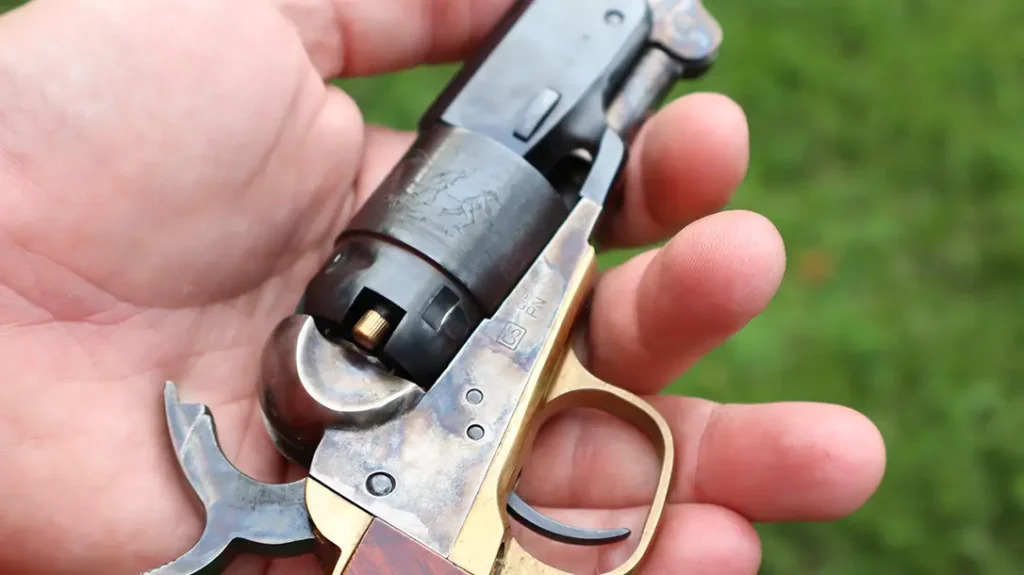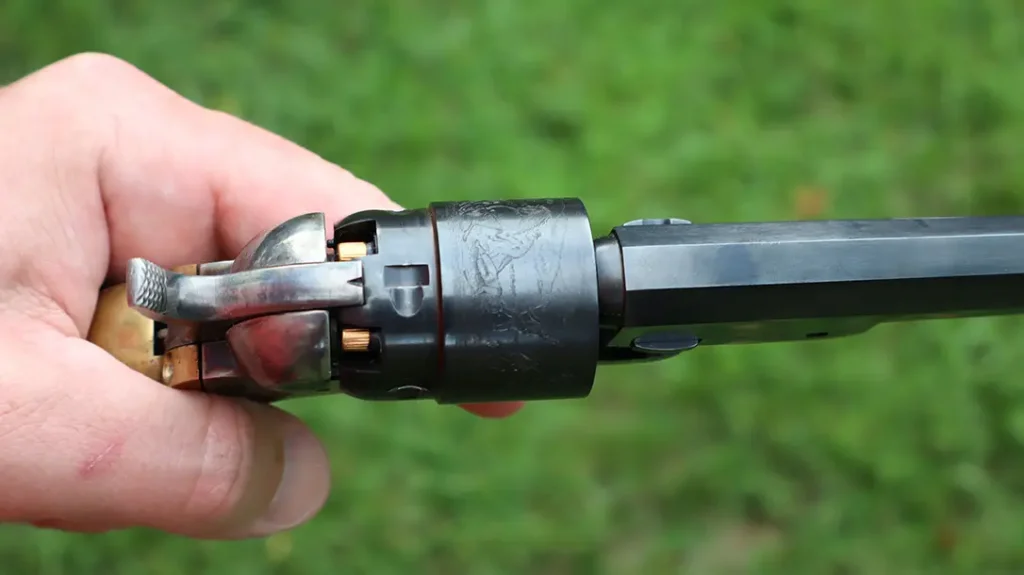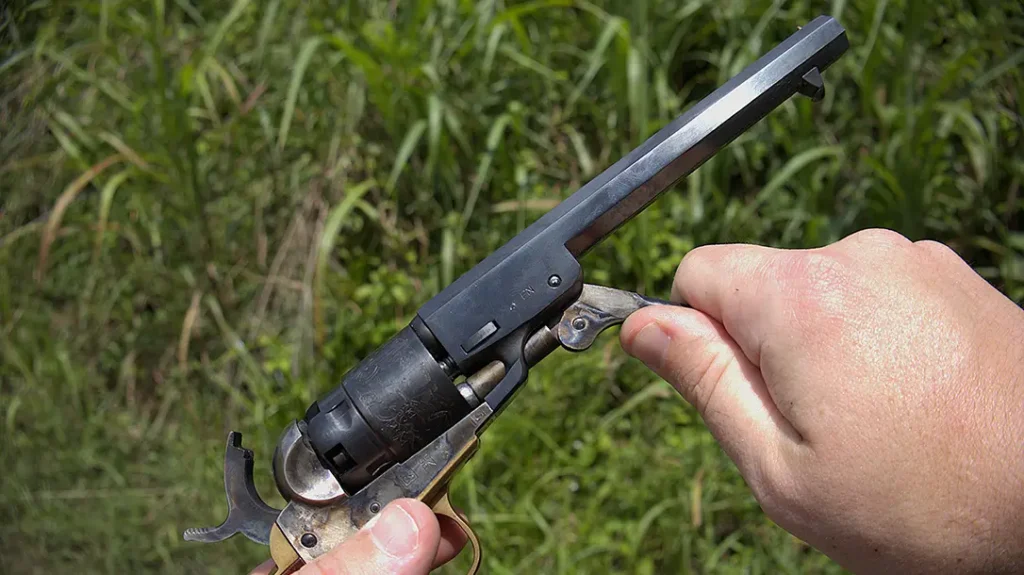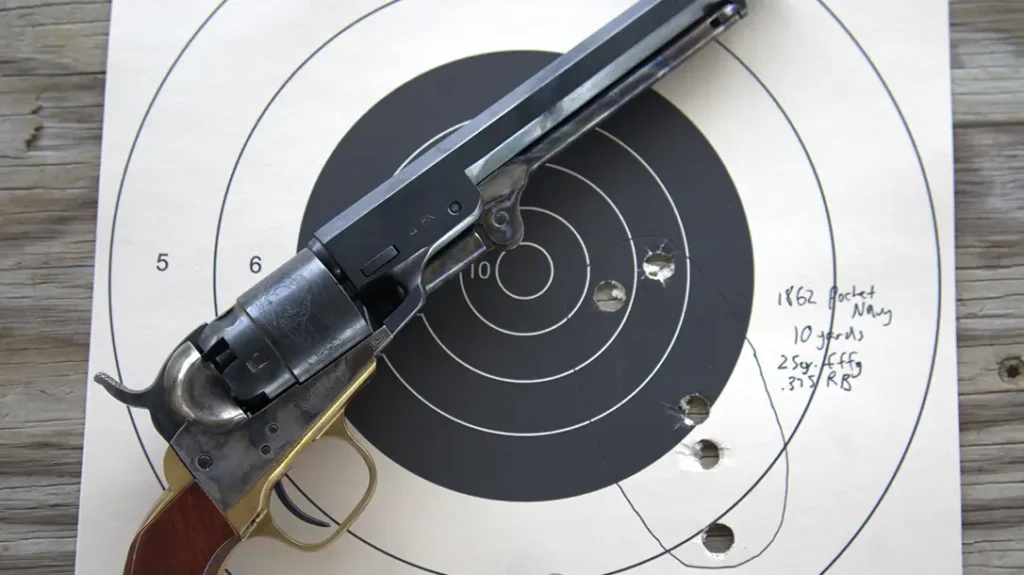If we made a list of obscure percussion revolvers, the Colt 1862 Pocket Navy, or New Model Navy, would be on that list in one form or another. This mix of modern and retro elements endeared shooters and soldiers to neither. Both the old model Colts and the new models far outsold the Pocket Navy. Less than 20,000 were produced from 1861 to the end of Colt’s cap and ball revolver line in 1873. But the Pocket Navy had its users, and it holds the distinction of being the last revolver Samuel Colt lived to see. Here is the story of the 1862 Pocket Navy and how it is getting a bit more love today.
Colt 1862 Pocket Navy – Reproduced by Taylors & Company
Samuel Colt invented the first practical revolver with his Paterson Repeating Belt Pistol in 1835. With the 1849 Pocket and 1851 Navy models, Colt had a pair of revolvers that were the most popular in the 19th century. Collectively, close to 600,000 of them were made. These models optimized Colt’s revolvers’ functionality and defined what quality looks like.
Advertisement — Continue Reading Below
The open top frame and octagonal barrel were not simply design quirks or beneficial features but were identified with Colt, the company. That look became ever more endearing when Colt’s patent on the revolver expired in 1857, and new players like Starr and Remington entered the market with options that would look more familiar to a modern shooter, namely a solid frame and modern revolver sights.
Markets Shape Monopolies
With Colt’s monopoly gone, he modernized his revolver line while retaining some of that trademark styling. Colt’s first task was to build a .44 caliber revolver that did not need a horse to carry it around. Instead of upsizing the Dragoon, Colt took the .36 caliber Navy up to size by cutting the water table on the Navy’s frame and belling the cylinder to accept the bigger bullet.
This feat was helped by the Bessemer process, which made steel cheaper to produce compared to iron. Coupled with strong, silver steel, a rounded barrel, and a rack-and-pinion loading lever, the new Frankenstein gun that became the Colt 1860 Army revolver packed more punch for its weight than anything on the market. Colt’s New Army revolver was quickly adopted by the US Cavalry that year, effectively supplanting the Dragoon and Navy pistols in Army service.
Advertisement — Continue Reading Below

Out with the Old, In With the Old
Samuel Colt applied the same principles to the other models in his lineup. The 1851 Navy gained the same round barrel and loading lever as the 1860 and became the New Model Navy. The 1849 Pocket revolver, popular with law enforcement, received the same belled-cylinder treatment from .31 to .36 caliber and, with the new barrel assembly, became the New Police or 1862 Police model. Despite its collector’s name, the 1862 Police came out in 1861 alongside the Pocket Navy.
These lesser-known revolvers have the dubious distinction of being the last Samuel Colt himself had a hand in, as he passed away in January 1862.
Advertisement — Continue Reading Below
Police Model
The 1862 Pocket Navy is essentially the same handgun as the Police model. It is based on the old Pocket model but upsized to a five-shot .36 caliber gun. The only difference is that the Pocket Navy uses the old hinge-style loading lever and octagonal barrel as seen on the 1851 Navy. The Pocket Navy had the advantage of being smaller and using the same .36-caliber ammunition as the bigger handgun. It also retained the same look that shooters were accustomed to.
But the Pocket Navy, along with most of the new lineup, did not sell well. Sales were cannibalized by the 1851 Navy and 1860 Army models, most of which were bought up by the US Army and Navy during the Civil War. Ultimately, over 250,000 old Navy models were made, while only 20,000 Pocket Navies were sold by the time production ceased.

Advertisement — Continue Reading Below
Taylor’s & Company’s 1862 Pocket Navy
Taylor’s & Company of Winchester, Virginia, is bringing in its own versions of the 1862 Pocket Navy, produced by Uberti in Italy. Their replica is available with barrel lengths of 4 ½, 5 ½, or 6 ½ inches and features the same styling Samuel Colt strived to maintain in the face of new innovations.
The 1862 Pocket Navy is available from Taylor’s with either a charcoal blue or standard hot blue finish to the octagonal barrel. The frame and loading lever are color casehardened, and the brass grip frame wears red-stained walnut grips. Like the old 1849 Pocket models, the 1862 Pocket Navy uses a fixed brass bead front sight and a small V-notch rear cut into the hammer nose. The grip frame between the two models is the same, except it is cut for an engraved, flared cylinder to accommodate five rounds of .36 caliber ammunition, with the same capacity as the .31 caliber model.
My particular Pocket Navy wears a 6 ½-inch barrel, which affords the highest velocity and, in my opinion, better balance than the shorter-barreled models.
Advertisement — Continue Reading Below
On the Range with the Colt 1862 Pocket Navy
Colt’s pocket models do not get the attention today that they did in the 19th century. The 1849 Pocket models were Colt’s most popular handgun of the era. Although Pocket Navy was not as successful, I had to wonder how the product’s improved version of the 1849 handled. I’ve had this Pocket Navy for five years and have a few hundred rounds through it. The shooting experience was not flawless, but in terms of practicality, the case can be made for it.

Teething Issues
The Pocket Navy is a single-action handgun that requires the hammer to be cocked for every shot. When I first received mine, I notched that the hammer seemed too easy to thumb back. On the range, that was confirmed as back pressure from firing would blow caps back against the hammer. When re-cocked, the spent caps would fall into the action and jam the works. I solved this problem by installing a second mainspring over the original, which made the hammer stiffer to cock but prevented all cap sucking problems. Afterwards, the Pocket Navy ran like a champ.
Advertisement — Continue Reading Below
Loading Procedures
In terms of loading and shooting, the 1862 Pocket Navy resides in an odd middle between the 1849 Pocket models and larger handguns like the 1851 Navy and 1860 Army. The grip is barely large enough for a full firing grip and is much thinner than those of larger handguns. The loading lever and loading port are also smaller. The .36 caliber chambers are easier to load compared to the smaller .31s, yet the cylinder is shorter and holds less powder than the .36 caliber 1851 Navy.
Despite these differences, the loading procedure is the same. First, the hammer is drawn back to half-cock so the cylinder spins freely for loading. Then the cylinder is loaded from the front with a measured charge of powder, followed by a bullet pushed on top with the loading lever. After loading up the front of the cylinder, the revolver’s cones at the back of the cylinder are primed with No. 10 percussion caps. Then the hammer can be lowered onto an empty chamber or onto one of the safety pins between cylinders to render the revolver drop-safe.

Powder in the Chamber
Hitting the .36 caliber chambers with powder and bullet is less of a trick than with smaller-caliber guns, and the loading lever provides plenty of leverage. Still, the loading port where the loading lever is located is small and sealed to prevent the user from skipping an unloaded projectile.
This arrangement works well with loose components, but there is not enough room to seat paper cartridges, which are combustible envelopes containing powder and a bullet. This was standard ammunition during the Civil War and common on the civilian market. Although I could shove a cartridge into the cylinder mouth, the long conical bullets would hang up on the loading port. This can be remedied by enlarging the port, but I chose to stick with loose components as I could change the charge and bullet, depending on what I happen to be shooting at.
Shooting Impressions
Although it is small compared to the most common cap and ball revolvers on the replica market, the 1862 Pocket Navy and its .36 caliber chambering have plenty of bark. My favorite load is an 80-grain, .375-inch-diameter round ball backed by 25 grains of FFFg Schuetzen black powder. That is close to a full chamber of powder with the oversized ball compressed on top.
Powder pours easily without spilling, and the round ball is easy to load. Recoil is brisk, but the sound, accompanied by smoke, leaves no doubt that you are firing something substantial. On my Caldwell chronograph, this load clocks in at about 960 feet per second, with about 160 foot-pounds of energy. The old .31 caliber 1849 Pocket, shooting a 50 grain bullet, only boasts 750 feet per second with 60 foot-pounds of energy.

20-grain Charge
My second-favorite load for the Pocket Navy is a 20-grain charge under a 130-grain cast Lee Conical bullet. Recoil is more pronounced in the palm, but it’s akin to comparing the recoil of a .22 LR to that of a .22 Magnum. The tale of the tape indicates an average velocity of 848 feet per second for 207 foot pounds of energy. The Pocket .36s fit the niche where a larger .380 pistol might today, stuck well above smaller caliber guns but below larger Army .44s.
Interestingly, although service-sized .36 caliber revolvers were capable of holding more powder, paper cartridges of the day were no more substantial than what I could cram into the Pocket Navy. Needless to say, the little Pocket Navy has some power to work with.
On paper, the conical load hits the point of aim at ten yards but is still rising at 25 yards. Given that revolvers like these were sighted in for longer distances, shooting high is not a surprise. The round-ball load is more consistent in terms of distance, but both loads yield groups the size of a fist. The accuracy is more than enough for a pocket pistol, and with some fine-tuning, pocket .36s like this can make a good small-game solution within reasonable ranges.

The Mini Navy Rides Again
The Colt Pocket Navy and Pocket Police revolvers were the last developed by Samuel Colt and hit the market at the worst possible time. The Civil War erupted just as these models hit the market, and soon, limited resources ensured production of service pistols was scaled up. After the war, there were so many handguns on the market that Colt and its competitors could not give them away. This series of unfortunate events disguises the fact that this new line of revolvers was perhaps the most promising.
Colt 1862 Pocket Navy
They were the micro-compacts of their time and delivered service-caliber power in a package previously reserved for lesser rounds. The Colt Pocket Navy pays homage to its bigger predecessor and gives up little in terms of power. Taylor’s version, despite its small size, is a fun gun to shoot with plenty of utility to boot.
For more information, visit Taylors & Company.
Colt 1862 Pocket Navy Specs:
| Caliber: | .36 caliber |
| Capacity: | 5 |
| Barrel Length: | 6.5 inches |
| Overall Length: | 11.5 inches |
| Width: | 1.5 inches (cylinder) |
| Height: | 4.5 inches |
| Weight: | 1 lb. 12 oz. (unloaded) |
WHY OUR ARTICLES/REVIEWS DO NOT HAVE AFFILIATE LINKS
Affiliate links create a financial incentive for writers to promote certain products, which can lead to biased recommendations. This blurs the line between genuine advice and marketing, reducing trust in the content.


